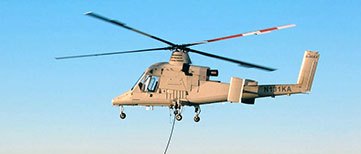
First came driverless cars, then came research into autonomous ships to help with transport freight emissions. Earlier this month Mercedes Benz tested an autonomous big rig on a public road and this week the news is of a pilotless helicopter being tested to help in the battles with wildfires in the United States. Autonomous and remote controlled vehicles are being used more and more in the battle for improved efficiency, safety and sustainability.
Earlier this week a Lockheed Martin helicopter capable of flying autonomously was launched in Idaho. Whilst the helicopter is capable of flying without a pilot, there was a safety pilot on board during the testing. The helicopter completed multiple drops of water that it had scooped up and then delivered to a demonstration ridge.
Why a pilotless helicopter?
Wildland fires are a big problem and there are many instances where conditions mean that helicopters have to be grounded when the reality is that if fires are to be contained quickly, activity needs to continue.
Firefighting from the air has to stop at night or when smoke reduces visibility and so manned helicopters need to be withdrawn when conditions are deemed too dangerous for a pilot. The pilotless helicopter is equipped with high tech sensors that allow it to fly when a pilot can’t. This could substantially increase the amount of time that aircraft could be tackling fires from the air.
The Lockheed Martin K-MAX uses 3 communication methods; line of sight and two satellite links. It can be flown autonomously after being told what to do or controlled remotely. It can complete programmed tasks even if it loses contact with the ground and can be programmed to fly to a specified landing point in the event it loses communication for an extended length of time.
This isn’t the first time the unmanned K-MAX has been used to remove the danger to human life in dangerous conditions. It has been flying in Afghanistan moving supplies and so removing the danger of troops encountering explosive devices on roads.
Having the option to go pilotless gives firefighting more versatility. The ability to be piloted or unmanned means that it can operate normally when not needed for firefighting or more dangerous unmanned duties. A pilot can fly or man the helicopter and when it becomes too dangerous, go back to base and switch to pilotless operations. Not only is it safer for the pilot but the aircraft will be able to fly much more frequently. Increased water drops in shorter period of time will allow wildfires to be contained much more quickly, improving the safety, not only of the firefighters, but also of the communities in the areas closest to the problem.
The data from the demonstration has yet to be analysed fully, but it’s hoped that the pilotless helicopter could be helping the firefighting lines from next year.
Read the full report here at Manufacturing.net
Image: Lockheed Martin
This site uses Akismet to reduce spam. Learn how your comment data is processed.


 Mail:
Mail: 




Leave a Comments